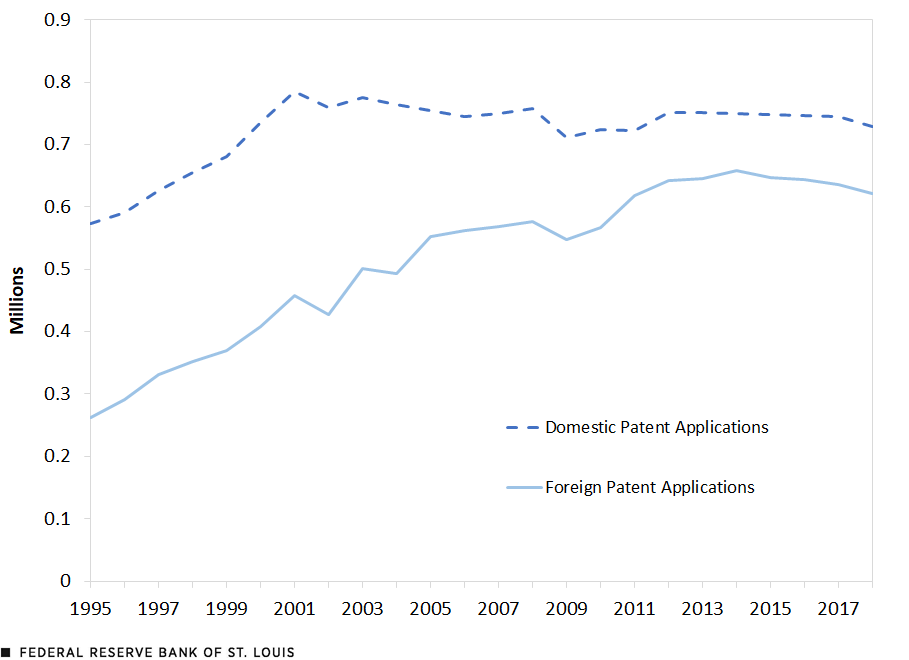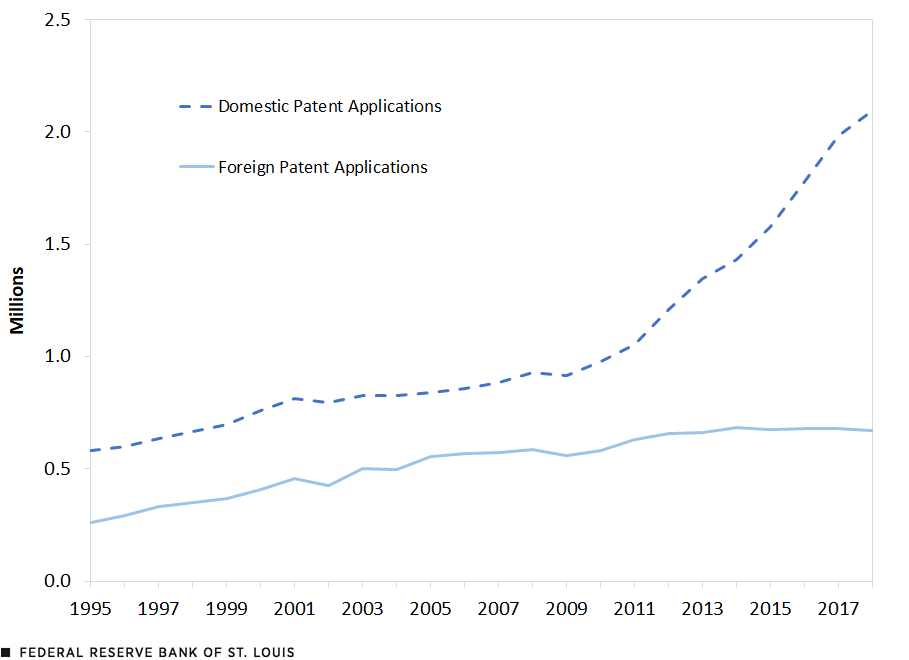The Rise of Cross-Border Patenting: Trends and Implications
In the world of intellectual property, the landscape for patent applications has undergone significant changes over the past few decades. A recent analysis of global data on domestic and foreign patent applications revealed a notable shift toward cross-border patenting, with foreign patent applications growing at a faster pace than domestic ones.See “Cross-Border Patenting, Globalization and Development,” Federal Reserve Bank of St. Louis Working Paper 2023-031C, which I co-authored with Jesse LaBelle, Inmaculada Martínez-Zarzoso and Yoto Yotov. For more on the effects that technology transfers through cross-border patenting have had on economic development and income inequality, see our February 2024 article, “Determinants and Impact of Cross-Border Patents: Evidence from a New Dataset,” in VoxEU from the Centre for Economic Policy Research.
Both figures below illustrate this trend, showing the evolution of domestic and foreign patent applications over time, first without and then with China included in the analysis. When China is excluded, the data indicate that between 1995 and 2018, foreign patent applications grew by an impressive 136%, far outpacing the 27% growth in domestic applications. The first figure shows three distinct periods in the evolution of cross-border patenting.
Number of Domestic versus Foreign Patent Applications Excluding China, 1995-2018

SOURCE: LaBelle, Martínez-Zarzoso, Santacreu and Yotov (2023).
Before 2000, foreign and domestic patent applications grew at a similar pace; foreign patent applications increased from about 263,000 in 1995 to 369,000 in 1999, while domestic patent applications rose from nearly 574,000 to over 681,000. During this period, the ratio of foreign to domestic patent applications was relatively stable at around 0.5. From 2000 to 2010, foreign patent applications experienced faster growth, rising to 567,000 and narrowing the gap with domestic patent applications. After 2010, both foreign and domestic patent applications’ continued growth was at a more similar rate, stabilizing the ratio of foreign to domestic patent applications at around 0.9, albeit with a higher level of internationalization compared with the pre-2000 era. In 2018, foreign patent applications were at 621,000, compared with 729,000 domestic patent applications.
Several factors have contributed to the faster growth of foreign patent applications. The harmonization of patent laws through the 1970 Patent Cooperation Treaty has streamlined the process of filing international patent applications, making it easier for innovators to seek protection in multiple countries. Globalization has also played a role, with increased international trade and foreign direct investment incentivizing companies to protect their intellectual property in foreign markets. Additionally, the inclusion of chapters on intellectual property rights in trade agreements has strengthened patent protection in participating countries, encouraging more cross-border patent filings.
China’s Effect on Global Patent Application Trends
When China is included in the analysis, as shown in the next figure, the picture changes due to China’s dramatic increase in domestic patent applications.For more on this topic, see my May 2018 Economic Synopses article, “What Does China’s Rise in Patents Mean? A Look at Quality vs. Quantity,” co-authored with Heting Zhu. For a separate analysis on the shift toward Asia of international patenting by U.S. inventors, see my December 2021 Economic Synopses article, “The Rise of Asia as a Destination for U.S. Patenting,” co-authored with Jesse LaBelle. China’s explosion in domestic patenting is unprecedented, with the number of domestic applications in that country increasing by a factor of 162 between 1995 and 2018. Globally, the number of domestic patent applications more than tripled between 1995 and 2018, rising to 2.1 million. This remarkable growth may be attributed to China’s generous patent subsidy programs, which are set to phase out by 2025, as announced by the China National Intellectual Property Administration on Jan. 27, 2021.
Number of Domestic versus Foreign Patent Applications Including China, 1995-2018

SOURCE: LaBelle, Martínez-Zarzoso, Santacreu and Yotov (2023).
Implications of Cross-Border Patenting
The rise of cross-border patenting has significant implications for innovators, businesses and policymakers. For innovators, it highlights the importance of considering international patent protection strategies to safeguard intellectual property in an increasingly globalized market. Businesses must navigate the complexities of multiple patent systems and develop strategies to protect their innovations in key markets. Policymakers, on the other hand, must strike a balance between encouraging innovation and ensuring a level playing field for domestic and foreign innovators.
In conclusion, the analysis of domestic and foreign patent applications reveals a clear trend toward cross-border patenting, driven by factors such as the harmonization of patent laws, globalization and the strengthening of protections for intellectual property rights in trade agreements. As the world becomes more interconnected, it is crucial for innovators, businesses and policymakers to adapt to this changing landscape and develop approaches that foster innovation while ensuring fair competition in the global marketplace.
Notes
- See “Cross-Border Patenting, Globalization and Development,” Federal Reserve Bank of St. Louis Working Paper 2023-031C, which I co-authored with Jesse LaBelle, Inmaculada Martínez-Zarzoso and Yoto Yotov. For more on the effects that technology transfers through cross-border patenting have had on economic development and income inequality, see our February 2024 article, “Determinants and Impact of Cross-Border Patents: Evidence from a New Dataset,” in VoxEU from the Centre for Economic Policy Research.
- For more on this topic, see my May 2018 Economic Synopses article, “What Does China’s Rise in Patents Mean? A Look at Quality vs. Quantity,” co-authored with Heting Zhu. For a separate analysis on the shift toward Asia of international patenting by U.S. inventors, see my December 2021 Economic Synopses article, “The Rise of Asia as a Destination for U.S. Patenting,” co-authored with Jesse LaBelle.
Citation
Ana Maria Santacreu, ldquoThe Rise of Cross-Border Patenting: Trends and Implications,rdquo St. Louis Fed On the Economy, June 11, 2024.
This blog offers commentary, analysis and data from our economists and experts. Views expressed are not necessarily those of the St. Louis Fed or Federal Reserve System.
Email Us
All other blog-related questions


